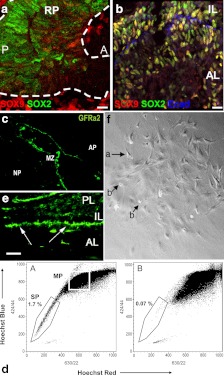Fig. 2.
Markers of putative pituitary stem cells. a and b, SOX9 is expressed in the embryonic pituitary gland and defines two populations of SOX2+ cells. At e12.5 (a), the majority of SOX2+ cells (green) are SOX9 negative (red) (RP, Rathke's pouch; A, anterior; P, posterior) (14). At e18.5 (b) and in adults, the majority of SOX2+ cells are SOX9+ cells (yellow staining); these cells are probably transit-amplifying cells (14). Some cells are still SOX2+, SOX9− (green) (AL, Anterior lobe; IL, intermediate lobe). E-cadherin (blue) is a marker of marginal cells and folliculostellate cells (14). c, The marginal zone of human adult pituitary contains a niche of progenitors expressing GFRa2 (15) (AP, Anterior pituitary; MZ, marginal zone; NP, neuropituitary). d, The adult mouse anterior pituitary contains a side population divided into SCA1high- and non-SCA1high - expressing cells. The SCA1high group are presumably endothelial progenitors, and non-SCA1high are presumably pituitary stem cells. Dual wave length FACS analysis reveals the presence of typical side population cells (1.7% of total living cells) in the adult anterior pituitary that are Hoechst low (d, A) and can be blocked by verapamil (d, B) (3) (SP, Side population; MP, main population). e, Nestin-GFP cells in mouse pituitary at birth. The cells are located almost exclusively in the perilumenal area of the pituitary (16) (AL, Anterior lobe; IL, intermediate lobe, PL, posterior lobe). f, Colony-forming pituitary cells in low-density culture colonies at d 8. Phase contrast low-power view showing stellate-shaped cells with long cytoplasmic processes (arrow a) and round refractile cells (arrow b). These cells express S100β and GFAP, which are folliculostellate markers (17). Panels a and b are reproduced from reference 14, with permission. © 2008, National Academy of Sciences. Panel c is reproduced from reference 15. Panel d is reproduced from reference 3, with permission. © 2005, The Endocrine Society. Panel e is reproduced from reference 16, with permission. © 2008, The National Academy of Sciences. Panel f is reproduced from reference 17, with permission. © 2005, Elsevier.

